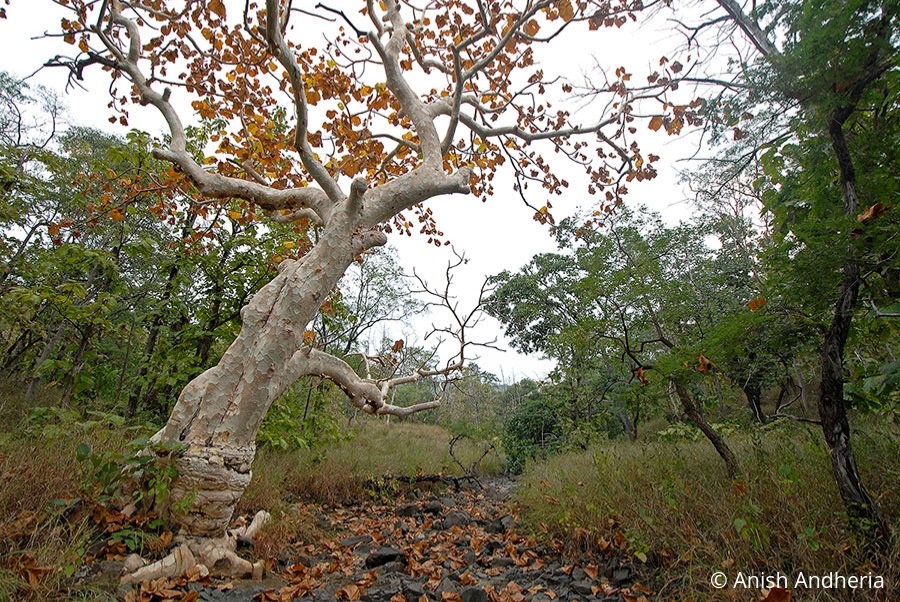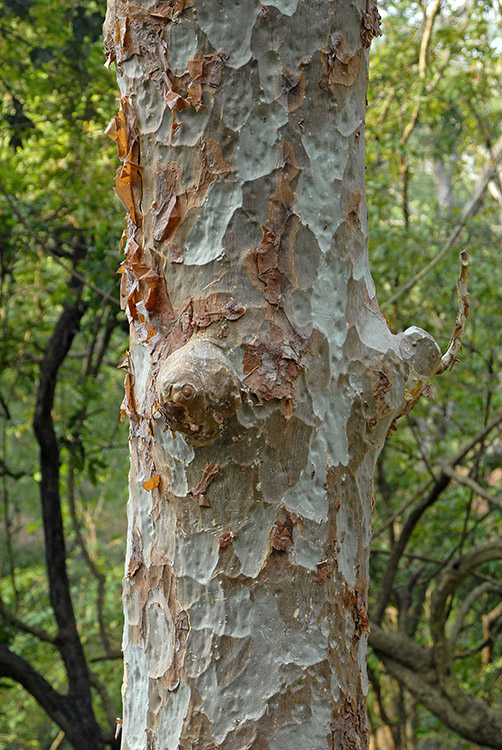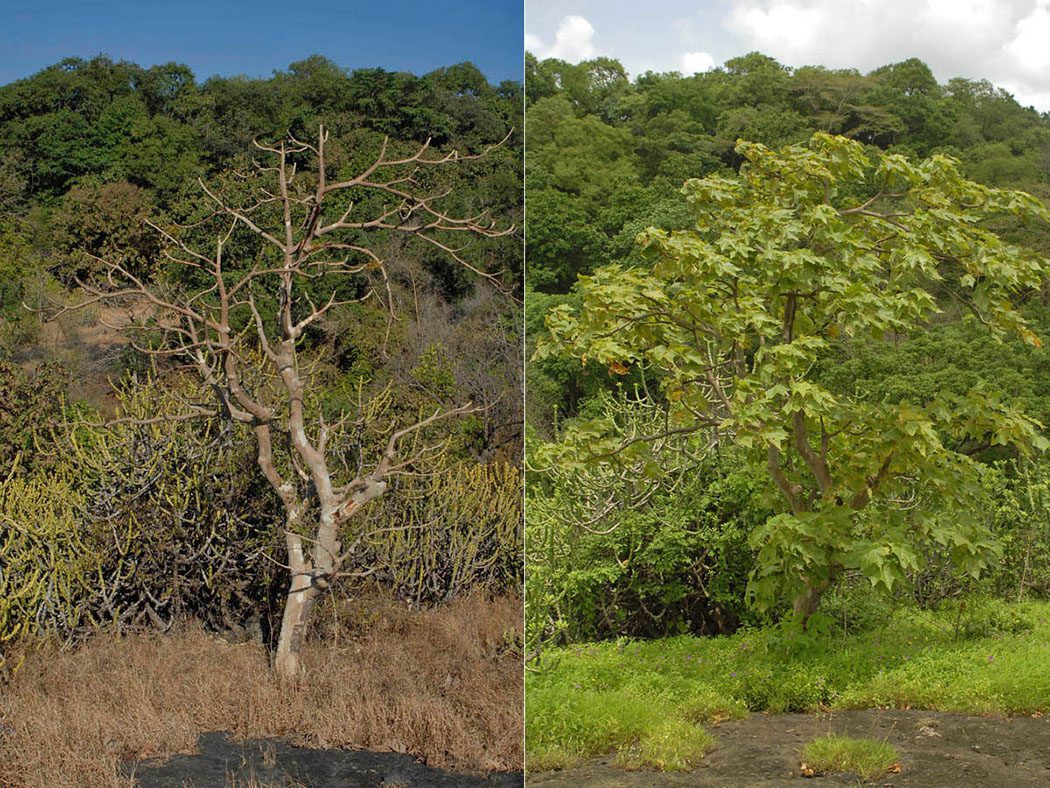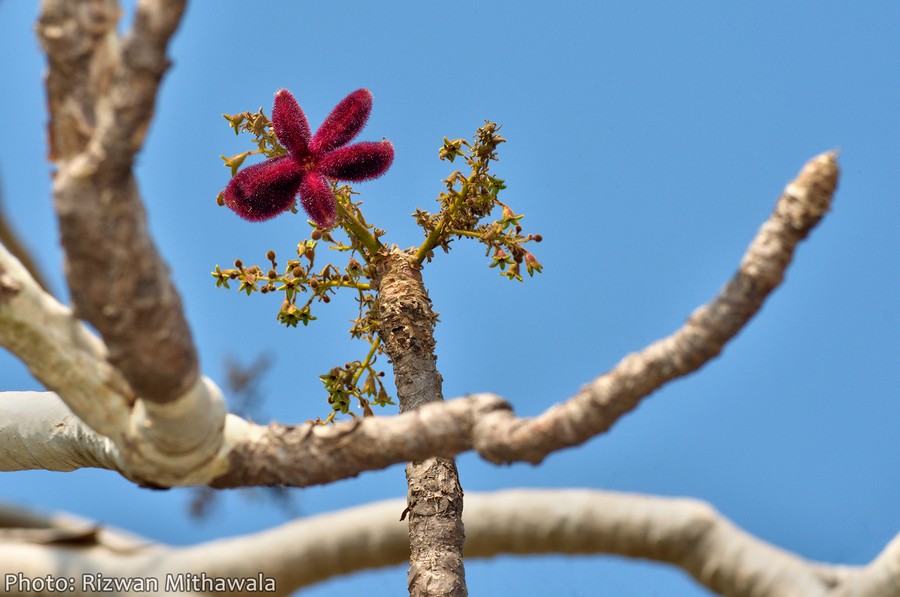
Like a mythical pale-and-smooth-skinned danseuse, with many arms outstretched, frozen in a mudra, is a tree that stands out against the scaly, warty and fissured barks of the brown-skinned denizens of India’s deciduous forests. It is stark, and striking, and never forgotten once seen. For a novice tree-spotter, the image of the Ghost Tree Sterculia urens stays rooted in memory for years.

The bark of the Ghost Tree Sterculia urens exfoliates in thin papery flakes. (Photo: Anish Andheria)
Beyond the awe and wonder that it inspires from a distance, on closer inspection, it reveals its life, one papery layer after another. The bark sheds its skin, like pieces of translucent parchment, in hues that range from pale peach to bright copper. Like a live canvas, the bark changes colour and texture with the seasons and as the tree ages. It’s not just the papery outer layer that peels off, thicker flakes of the bark chip off in varied shapes, leaving shallow dents that bring to life the play of light and shadow as the sun moves across the rocky slopes and vertical cliff faces where the tree’s shallow roots find firm footing.
 The tree remains leafless for more than six months. Leaves start falling in October, and most trees are completely bare by December (left). New leaves appear only by the end of May or early June (right). (Photo: Anish Andheria)
The tree remains leafless for more than six months. Leaves start falling in October, and most trees are completely bare by December (left). New leaves appear only by the end of May or early June (right). (Photo: Anish Andheria)
At home in dry, hilly areas, it has evolved to withstand drought partly by going leafless for more than six months. Its large, palmate leaves, deeply heart-shaped at the base and tapering at the tips of multiple lobes, start yellowing and falling around October. New leaves appear only by the end of May or early June. Till then, it’s time for bare splendour. From December to March, clusters of small, bristly, bell-shaped calyxes open out into five petal-like lobes forming apple green, star-shaped flowers. In the centre, is a red ‘bullseye’ that guides honey bees to the nectar. Fruits appear soon after – five pairs of pursed, velvety lips, bright maroon at first, turning khaki-green with generous tinges of red as they ripen. The velvety surface is too luscious and invites a hand to touch, only to deliver a sting. Undeterred by the stinging hairs, monkeys feed on the seeds as soon as the ripe fruit opens. Hornbills, too, eat the fruit, and disperse the seeds away from the parent trees, so saplings can find their own rocky niche under the sun.
Botanically, the tree is named after the stinging hairs on its flowers and fruits – Urens is Latin for stinging. Commonly called Kulu in Central India, and by a host of other names across the country, it is also popular as Gum Karaya for the gum it exudes when the bark is damaged. It is tapped for use in the pharmaceutical industry as a laxative and a tablet binder.

The tree is named after the stinging hairs on its flowers and fruits – Urens is Latin for stinging.
Gum oozes from a tree when it’s wounded; yet, it too, becomes a commodity for us humans, and cures our maladies. But that’s the case with all human needs that are met only by harvesting organic substances from other living beings. As every overkill is justified as ‘fulfilling a need’, there is no discussion on where’s the tipping point of the exploitation of nature at the hands of humans, and whether it’s already crossed. Whether we discuss or digress, we will not be able to run away from the consequences.
In the interest of trees, and humans, trees should be allowed to live their lives – soak up the sun; flaunt brazen blooms; bamboozle sex-crazed bees and wasps; smear bat noses with pollen; bear luscious fruit; beget plenty of their kind, pass to them their wisdom, and see them thrive; gracefully age; and die a natural death.
The arresting image of the Ghost tree epitomises the beauty of all forest trees, diverse in the textures of their barks, the sexual lives of their flowers, the forms of their fruits, and the shapes of their leaves. To appreciate their beauty and grace, and to observe them live their lives, can fill the human heart with joy and gratitude. And that’s a good state to be in.
——————————————————————————————————————————————————————
Rizwan Mithawala is a Conservation Writer & Editor with the Wildlife Conservation Trust and a Fellow of the International League of Conservation Writers.
——————————————————————————————————————————————————————
Disclaimer: The author is associated with Wildlife Conservation Trust. The views and opinions expressed in the article are his own and do not necessarily reflect the views and opinions of Wildlife Conservation Trust.
Related Links
- Birding in Tigerland
- Quadripartite Association
- Mumbaikars take part in a panel discussion on ‘Wildlife and the City’
